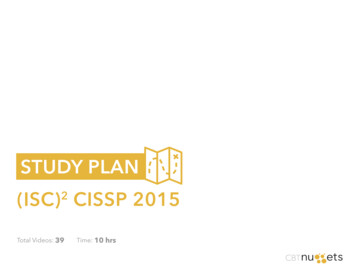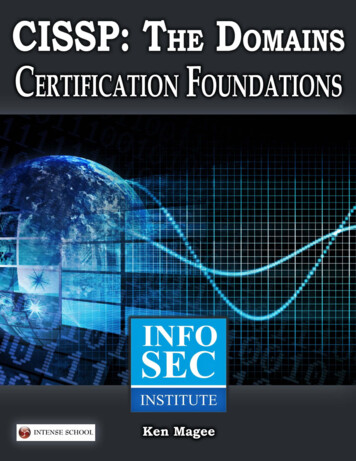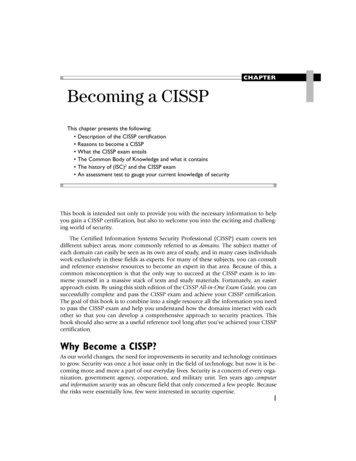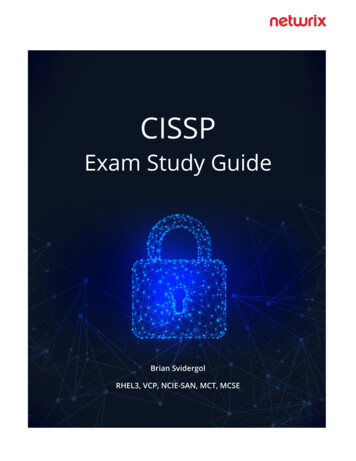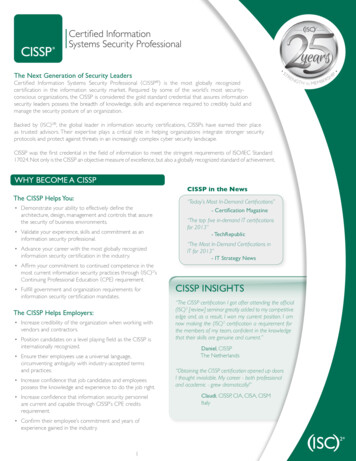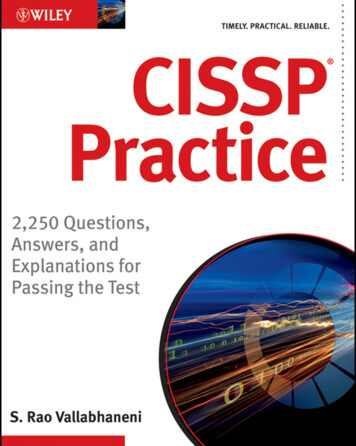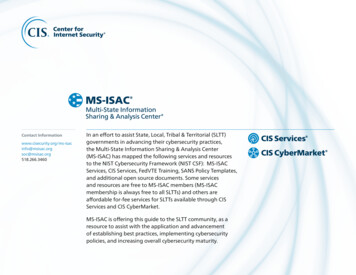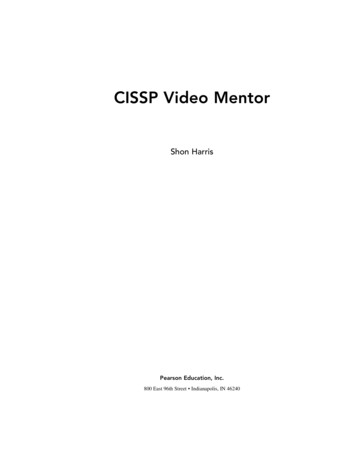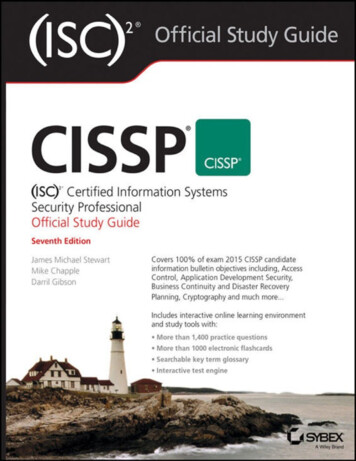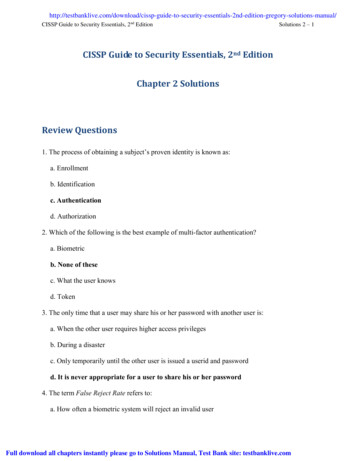
Transcription
CISSP Guide to Security Essentials 2nd Edition Gregory Solutions ManualFull Download: nual/CISSP Guide to Security Essentials, 2nd EditionSolutions 2 – 1CISSP Guide to Security Essentials, 2nd EditionChapter 2 SolutionsReview Questions1. The process of obtaining a subject’s proven identity is known as:a. Enrollmentb. Identificationc. Authenticationd. Authorization2. Which of the following is the best example of multi-factor authentication?a. Biometricb. None of thesec. What the user knowsd. Token3. The only time that a user may share his or her password with another user is:a. When the other user requires higher access privilegesb. During a disasterc. Only temporarily until the other user is issued a userid and passwordd. It is never appropriate for a user to share his or her password4. The term False Reject Rate refers to:a. How often a biometric system will reject an invalid userFull download all chapters instantly please go to Solutions Manual, Test Bank site: testbanklive.com
CISSP Guide to Security Essentials, 2nd EditionSolutions 2 – 2b. How often a biometric system will accept an invalid userc. How often a biometric system will reject a valid userd. How often a biometric system will accept a valid user5. Password quality refers to:a. Password encryptionb. Password expirationc. Password complexityd. All of the above6. Every month, the human resources department issues a list of employees terminated in theprevious month. The security manager should:a. Use the list to conduct an audit of computer accounts to make sure the terminatedemployees’ accounts have been terminatedb. Make sure that computer accounts are terminated as soon as possible after the issuance ofthe list of terminated employeesc. Request that the human resource department notify account managers ofterminations daily instead of monthlyd. Request that the list of terminated employees be encrypted for security reasons7. The principal security weakness with RADIUS is:a. Traffic is not encryptedb. Passwords do not expirec. It uses the TCP protocold. RADIUS sessions are connectionless8. The use of LDAP as a single source for authentication data helps an organization to achieve:
CISSP Guide to Security Essentials, 2nd EditionSolutions 2 – 3a. Fewer password resetsb. Effective password managementc. Single sign-ond. Reduced sign-on9. An auditor has produced a findings report that cites the lack of separation of duties as asignificant problem. Management should consider:a. Separating development and production environmentsb. Outsourcing the indicated processc. Stop outsourcing the indicated processd. Examining the indicated process and reassigning duties among a greater number ofindividuals10. All of the following controls are preventive controls EXCEPT:a. Fencingb. Surveillance camerasc. Firewallsd. Bollards11. An attack on a server that originates from many sources is known as a:a. DDoSb. DoSc. Botnetd. Teardrop12. The most effective way to protect audit log data is to:a. Write audit log data to tape
CISSP Guide to Security Essentials, 2nd EditionSolutions 2 – 4b. Write-protect audit log datac. Write audit log data to write-once mediad. Write audit log data to optical storage13. The purpose of a defense in depth strategy is:a. To make protected assets difficult to findb. To ensure that protected assets are reachablec. To protect assets from unauthorized accessd. To protect assets using a variety of controls14. Anti-malware is a form of:a. Preventive controlb. Detective controlc. Corrective controld. Recovery control15. The most effective way to prevent password cracking is:a. Make the password hash files inaccessibleb. Remove password cracking tools from the target systemc. Protect passwords using strong encryptiond. Remove the target system from the networkHands-On ProjectsProject 2-1Students are directed to observe the levels of authentication through experiencing the
CISSP Guide to Security Essentials, 2nd EditionSolutions 2 – 5online merchant Amazon.com. The levels that the student will observe are:1. No identification. Here, the site knows nothing about the user’s identity. This isseen in step 3.2. Identification. Here, the site remembers the user’s identity through a persistentcookie. This is seen in step 5.3. Authentication. Here, the site recognizes the user’s identity through a sessioncookie. This is the highest level of authentication, where the user is permitted toperform transactions.Instructors may have students perform this exercise using a different web site. The website behavior that is implemented by Amazon is commonly used.Project 2-2In this project, students set up and interact with firewall software. This helps students tobetter understand how firewalls work by performing tasks on their computer andobserving (directly and through review of log entries) firewalls at work.Project 2-3Students have the opportunity to observe anti-virus software, without risking infectionwith real malware. After checking to see that their computer’s anti-virus software isinstalled, running, and properly configured, students are directed to download the EICARtest file from eicar.org.EICAR test files are simple text files containing a string of characters that virtually all
CISSP Guide to Security Essentials, 2nd EditionSolutions 2 – 6anti-virus programs recognize as malware. This capability was developed as a safe way totest whether anti-virus software is actually working properly. An EICAR test file does notcontain code or anything harmful—just a string of characters that matches a signature inan anti-virus program’s database.Project 2-4In this project, students are able to encrypt and decrypt text files and be able to observeplaintext and corresponding ciphertext. Students are directed to use WinZip, although7Zip may also be used. Mac users can use the built-in zip command.Instructors may direct students to experiment with encryption, to help students observehow ciphertext changes greatly even when the plaintext or the key is changed slightly.You may explain that this is a part of the value of modern cryptography, which makes itdifficult for an attacker to break a cryptosystem.Case ProjectsCase Project 2-1In this project, students are asked to develop a specification for initial registration andauthentication into an investment management system. For each use case, students aredirected to specify what users of the system are required to do to complete each function.Students may draw from their experience in dealing with online merchants and onlinebanking to develop the plan. Features that students might use include:
CISSP Guide to Security Essentials, 2nd EditionSolutions 2 – 7 Various methods of confirmation for initial registration Reauthenticating when performing sensitive transactions Multi-factor authentication Various methods of confirming sensitive transactions to prevent cross-site requestforgery and other attacks After-the-fact notification of sensitive transactions Various methods (such as CAPTCHA) to confirm that the subject performing atransaction is a human and not a machineCase Project 2-2Students are directed to observe a real-world set of defense in depth controls used toprotect an IT system or a physical work facility.Instructors need to be sure that students understand the difference between defense indepth and resilience. For example, two separate paths from the Internet to an applicationserver, each with its own firewall, is not a defense in depth but the avoidance of a singlepoint of failure.As another example, a firewall and an anti-virus gateway could be considered a defensein depth—in general—against malware, although each protects in its own way. Similarly,while a moat and a drawbridge each protect a castle from intruders, they do so indifferent ways: a moat may block a good climber who cannot swim, whereas adrawbridge may block a good swimmer who cannot climb.
CISSP Guide to Security Essentials, 2nd EditionSolutions 2 – 8Case Project 2-3Students are asked to learn about script injection vulnerabilities (including JavaScriptinjection and SQL injection), by finding one or more sites that visibly demonstrate asuccessful injection attack.Students are then asked to describe potential safeguards that can be used to protect asystem against injection attacks. In general, students should take one of these approaches: A system could carefully parse and sanitize input fields to remove any and allsigns of code injection A system could provide a more intelligent list of choices instead of using afreeform text field. For example, a system that requests a date could use dropdown values that a user would select, as opposed to asking the user to input adate.In a classroom setting, students could weigh the value in the two above approaches, aswell as any others that are proposed.Case Project 2-4In this project, students are asked to develop a user access request process. Here, studentswill need to think beyond the use of technology and understand how technology can beeffectively applied in a real organization.The process that students need to develop will contain a request form, two procedures,and recordkeeping. Students with different thinking styles will develop different results;some may develop a flowchart while others will develop step-by-step instructions.The final step of the case project asks students to discuss how auditors would audit a user
CISSP Guide to Security Essentials 2nd Edition Gregory Solutions ManualFull Download: nual/CISSP Guide to Security Essentials, 2nd EditionSolutions 2 – 9access request process. This helps students see their business process (and underlyingtechnology) from the outside in.In the classroom, an instructor could direct students to trade their process documents andask students to comment on the ability to audit processes developed by other students.This would help students experience objectivity by viewing processes developed byothers.Full download all chapters instantly please go to Solutions Manual, Test Bank site: testbanklive.com
CISSP Guide to Security Essentials, 2nd Edition Solutions 2 – 1 CISSP Guide to Security Essentials, 2nd Edition Chapter 2 Solutions Review Questions 1. The process of obtaining a subject’s proven identity is known as: a. Enrollmen
